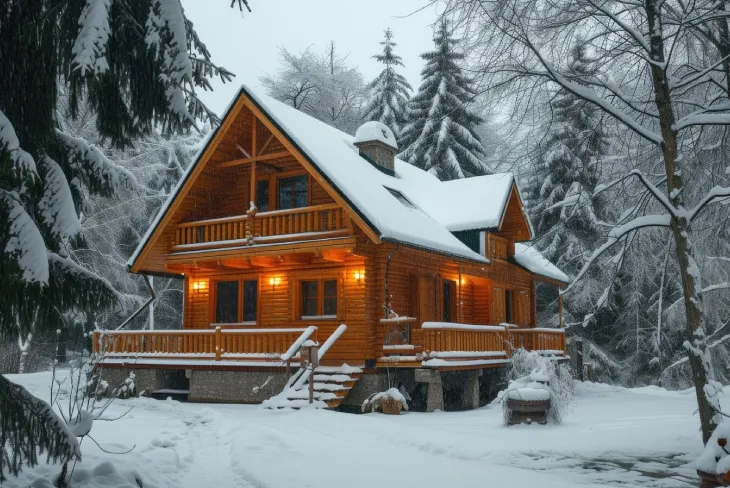Log cabins have long been cherished for their rustic charm and cozy ambiance. However, to ensure that a log cabin with insulation remains comfortable and energy-efficient throughout the year, proper insulation is important. Effective insulation not only keeps the cabin warm in winter and cool in summer but also reduces energy costs and environmental impact.
This blog post explores the benefits of insulating a log cabin, the different types of insulation available, and practical tips for achieving enhanced comfort and energy efficiency.
Benefits of Insulating a Log Cabin
1. Enhanced Comfort
Proper insulation helps maintain a stable and comfortable indoor temperature, regardless of the weather outside. It prevents cold drafts during the winter and keeps the interior cool during the summer, ensuring a pleasant living environment year-round.
2. Energy Efficiency
Insulation significantly reduces the need for heating and cooling, leading to lower energy bills. An energy-efficient log cabin minimizes heat loss in winter and heat gain in summer, optimizing the performance of HVAC systems.
3. Moisture Control
Insulation plays a vital role in controlling moisture levels within the cabin. By preventing condensation and moisture buildup, it helps protect the wooden structure from rot, mold, and mildew, thereby extending the cabin’s lifespan.
4. Soundproofing
Insulation also provides soundproofing benefits, reducing noise from the outside and creating a quieter indoor environment. This is particularly beneficial in rural or forested settings where outdoor noises can be prevalent.
5. Increased Property Value
A well-insulated log cabin is more attractive to potential buyers. Proper insulation is often seen as an indicator of a well-maintained property, increasing its market value and appeal.
Types of Insulation for Log Cabins
1. Fiberglass Insulation
Fiberglass insulation is one of the most common types used in log cabins. It consists of fine glass fibers and is available in batts or rolls. Fiberglass is affordable, easy to install, and effective at reducing heat loss. It is typically installed in the walls, floors, and ceilings of the cabin.
2. Spray Foam Insulation
Spray foam insulation is a popular choice for log cabins due to its excellent insulating properties. It is applied as a liquid that expands into a foam, filling gaps and sealing air leaks. Spray foam provides a high R-value (a measure of thermal resistance) and creates an airtight barrier, making it highly efficient.
3. Rigid Foam Insulation
Rigid foam insulation is available in sheets or panels and is used for insulating walls, roofs, and floors. It offers a high R-value and is moisture-resistant, making it suitable for areas prone to dampness. Rigid foam is durable and provides excellent thermal performance.
4. Natural Fiber Insulation
Natural fiber insulation, such as sheep’s wool, cellulose, and cotton, is an eco-friendly option for log cabins. These materials are renewable, biodegradable, and provide good thermal and acoustic insulation. They are also safe to handle and free from harmful chemicals.
5. Reflective Insulation
Reflective insulation, also known as radiant barrier insulation, is designed to reflect heat away from the cabin. It is typically installed in the roof or attic and helps keep the interior cool during hot weather. Reflective insulation is often used in combination with other types of insulation for optimal performance.
Tips for Insulating Your Log Cabin
1. Insulate the Roof
The roof is a major source of heat loss in a log cabin. Properly insulating the roof is important for maintaining a comfortable indoor temperature. Use high-quality insulation materials, such as spray foam or rigid foam, and ensure there are no gaps or air leaks.
2. Insulate the Walls
Log walls have natural insulating properties, but additional insulation can enhance their performance. Consider using spray foam insulation to fill gaps and cracks in the logs. Alternatively, install rigid foam panels on the interior or exterior of the walls for added insulation.
3. Insulate the Floor
Insulating the floor helps prevent cold air from entering the cabin and keeps the indoor temperature stable. Use fiberglass batts or rigid foam insulation to insulate the floor joists. Ensure the insulation is protected from moisture by using a vapor barrier.
4. Seal Gaps and Cracks
Air leaks can significantly reduce the effectiveness of insulation. Inspect your log cabin for gaps and cracks around windows, doors, and other openings. Use caulk or weatherstripping to seal these gaps and prevent drafts.
5. Use Double-Glazed Windows
Windows are another potential source of heat loss. Replace single-glazed windows with double-glazed ones to improve insulation and reduce energy loss. Double-glazed windows have two panes of glass with an insulating layer of air or gas between them, providing better thermal performance.
6. Consider Adding an Insulation Barrier
An insulation barrier, such as house wrap or vapor barrier, can be added to the exterior of the log cabin to improve insulation. This barrier helps prevent air infiltration and moisture buildup, enhancing the overall energy efficiency of the cabin.
7. Regular Maintenance
Regular maintenance is essential to ensure the insulation remains effective. Inspect the insulation periodically for signs of damage or wear, and make any necessary repairs. Check for air leaks and seal them promptly to maintain the cabin’s energy efficiency.
Conclusion
An insulated log cabin offers numerous benefits, including enhanced comfort, energy efficiency, moisture control, and soundproofing. By choosing the right insulation materials and following best practices for installation, you can create a warm and cozy retreat that is enjoyable year-round. Whether you’re building a new log cabin or upgrading an existing one, investing in proper insulation is a smart decision that will pay off in comfort, cost savings, and increased property value.




No Comment! Be the first one.